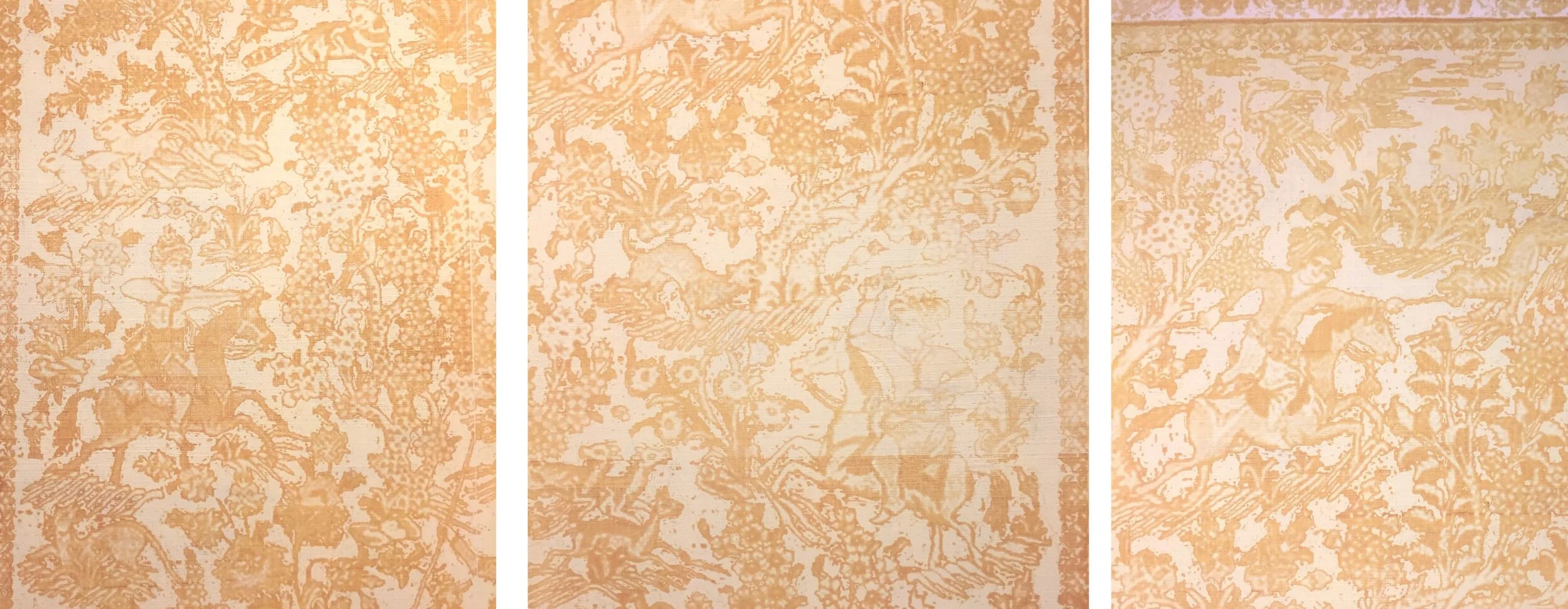Searching for Traces of History in Kour Pour’s Carpet Paintings
In two rooms across the hallway from each other at Minnesota Street Projects lives Manzareh/Keshiki/Landscape,the solo exhibition by Kour Pour at Ever Gold [Projects]. Nearly a mini-retrospective, the exhibition spans two gallery spaces and numerous series. It is a rare treat to see so much of a young artist’s work at once — viewing new paintings in the context of their predecessors is both joyful and illuminating.
A first impression in color
Upon my first visit, I was enchanted by a large piece in the second gallery, one of his new ‘carpet’ paintings. I had long since been allured by Pour’s abstract work in block print and painting, which use historical methods of creating to re-examine the ways in which we glorify culture and tradition from “exotic” societies. Pour’s carpet paintings are an extension of this investigation. When I started seeing images over a year ago, I was intrigued. The works were familiar thanks to a palette of rich and nostalgic ochres, clay reds and muted blues, yet differed greatly in composition, figurative and decorative details grace the canvas in a highly organized manner.
Facing the towering painting (pictured below), I was struck by the sheer sentiment of the piece. Narrative cycle and decorative elements both benefit from exquisite draftsmanship — while “weathered” areas lend credibility to the weight of the history, while the agility of a horse or the thoughtfulness of a figure is achieved through a few simple marks.
Kour Pour, Foreign Traveler, 2019. Acrylic on canvas over panel, 96 x 72 inches. Courtesy the artist and Ever Gold [Projects].
Once my awe receded, I set about understanding. Trying the read the narrative cycle by an artist predominately known for abstraction presents an interesting challenge. Starting with the title Foreign Traveler, the painting seems to tell the story of a trader of emissary, in an exotic land. The bulk of the conflict takes part in the yellowed center section of the painting, yet there are numerous characters, the titular traveler is not obvious, though I’m inclined to believe it is the man in the red shirt beneath the elephant. He is the most confidentially painted, and looks backward in reflection as he continues his journey.
Trials and rewards await this traveler, as scenes of danger (both of human and natural kind) and relaxation abound across the center area. Turning towards the red-tinted exterior, there is a repetitive motif of angels, men lost in mediation, and predators and prey interlocked with one another. These characters give the impression that the traveler’s journey has been foretold, and the events along the away are entirely out of his control. There is an order and a system to life that he cannot escape, whether he recognizes it or not.
Behold, the monochrome abstraction
It wasn’t until my third visit to the exhibition, at a moment where I was not anticipating discovery, that I regarding very closely Foreign Traveler’s “sister painting,” a carpet painting of the same formidable format, yet rendered in a very narrow range of a single color, Biege.
Kour Pour, Beige, 2019. Acrylic on canvas over panel, 96 x 72 inches. Courtesy the artist and Ever Gold [Projects].
From afar, or without close study, Beige appears entirely abstract, more in line with Pour’s work than its colored counterpart. yet upon closer examination, the painting is in fact composed of countless figurative details — heroic figures on horses waving swords, peacocks in flight, jungle cats and rabbits pouncing from hidden places. Even from up close, these details can be easily lost among the decorative, floral flourishes.
Despite these figurative elements, the narrative is even less clear than in Foreign Traveler. Rather than tell a story itself, the painting alludes to storytelling as an act, and as an inherent property of both carpets and paintings.
Details of Beige, by Kour Pour
Narrative and detailed carpets have become historic relics, less and less in vogue. Similar to the trend in painting, modern rugs veer towards minimalism and abstraction. The allusion to the carpet for Pour is not to recreate an art form, rather, to use it as a vehicle to understand the acts of painting and storytelling. The narratives in Foreign Traveler and in Beige are intentionally vague, a warning perhaps about the way we record history, and its tendency to fade away…
